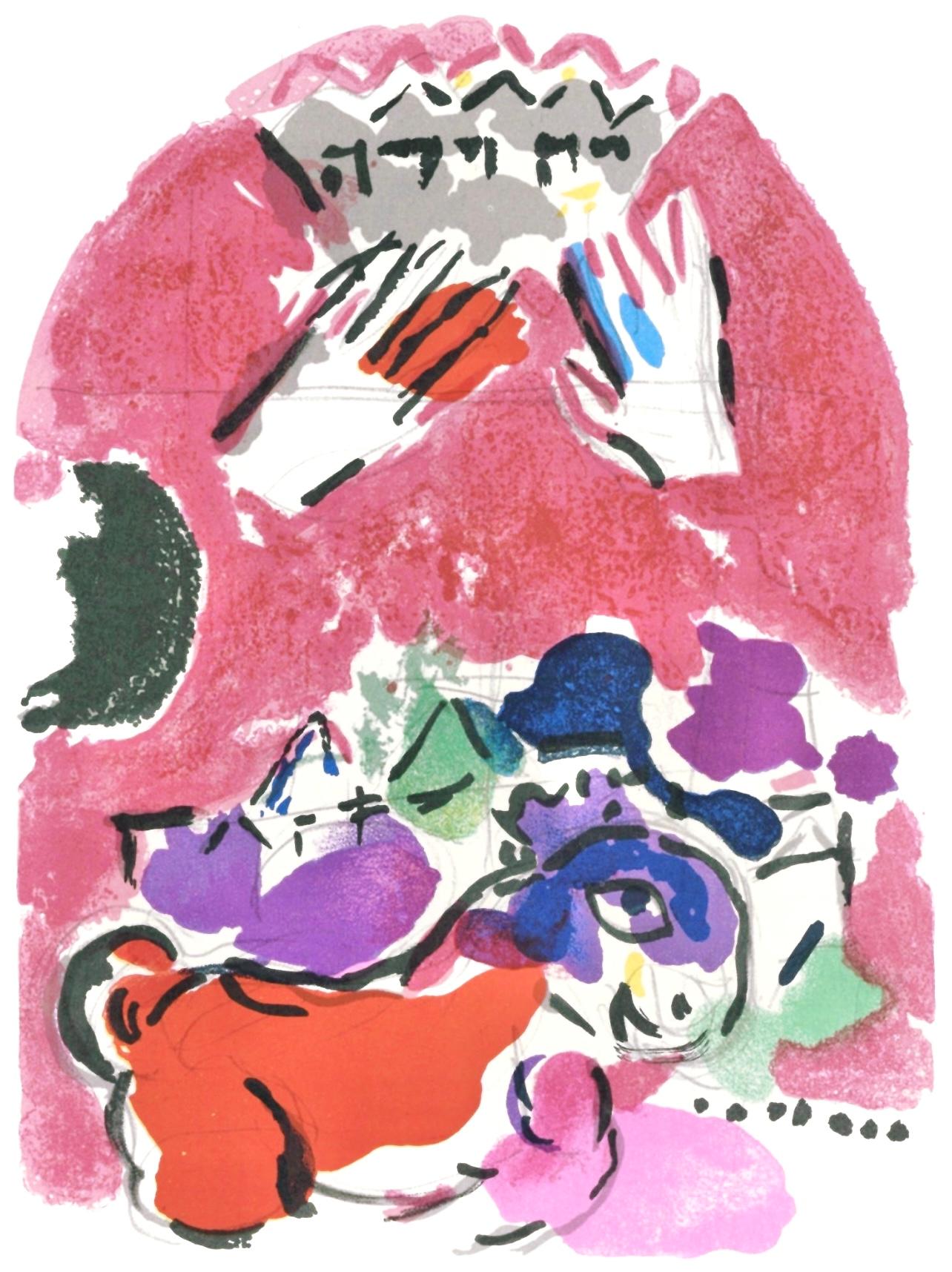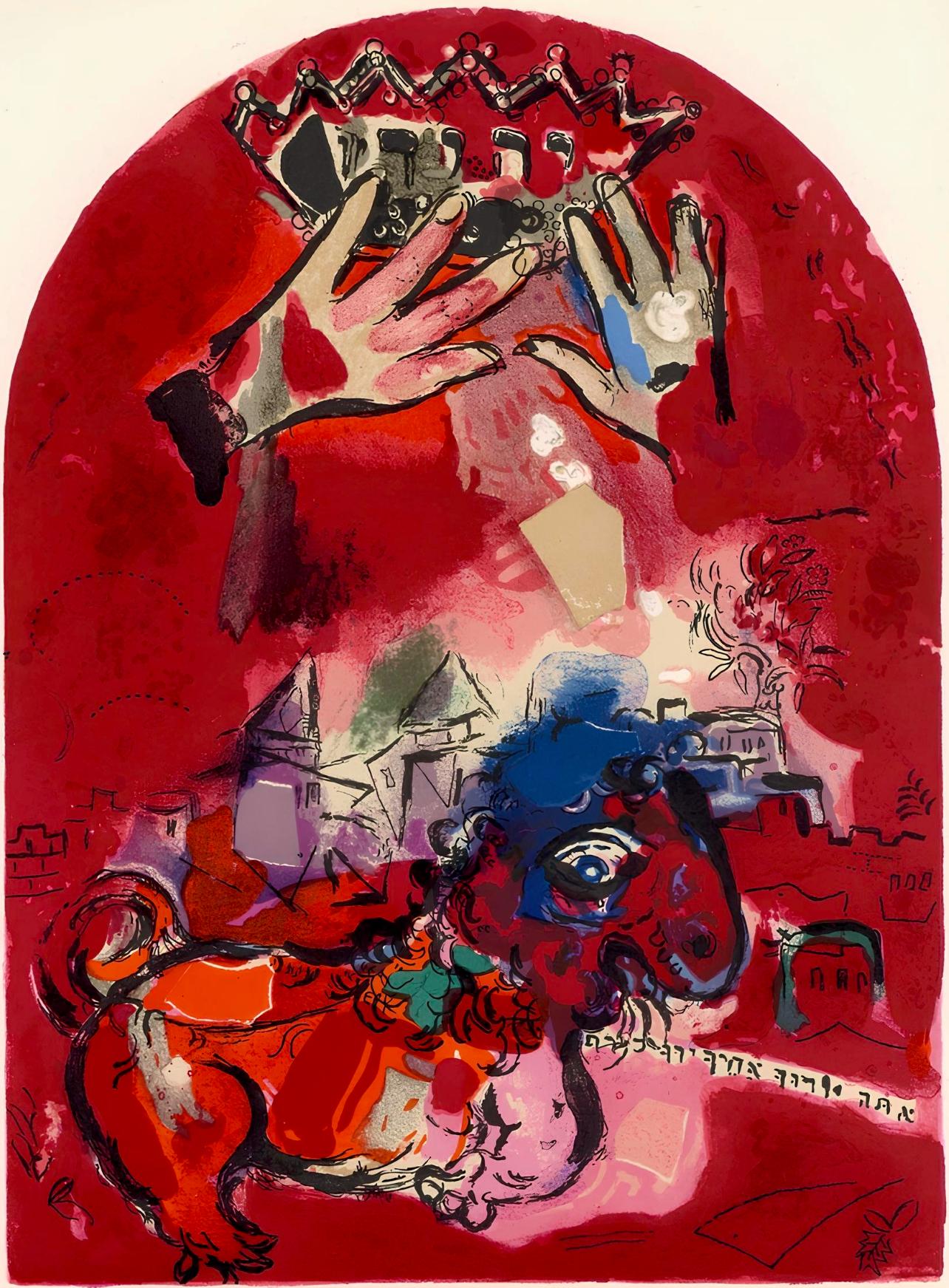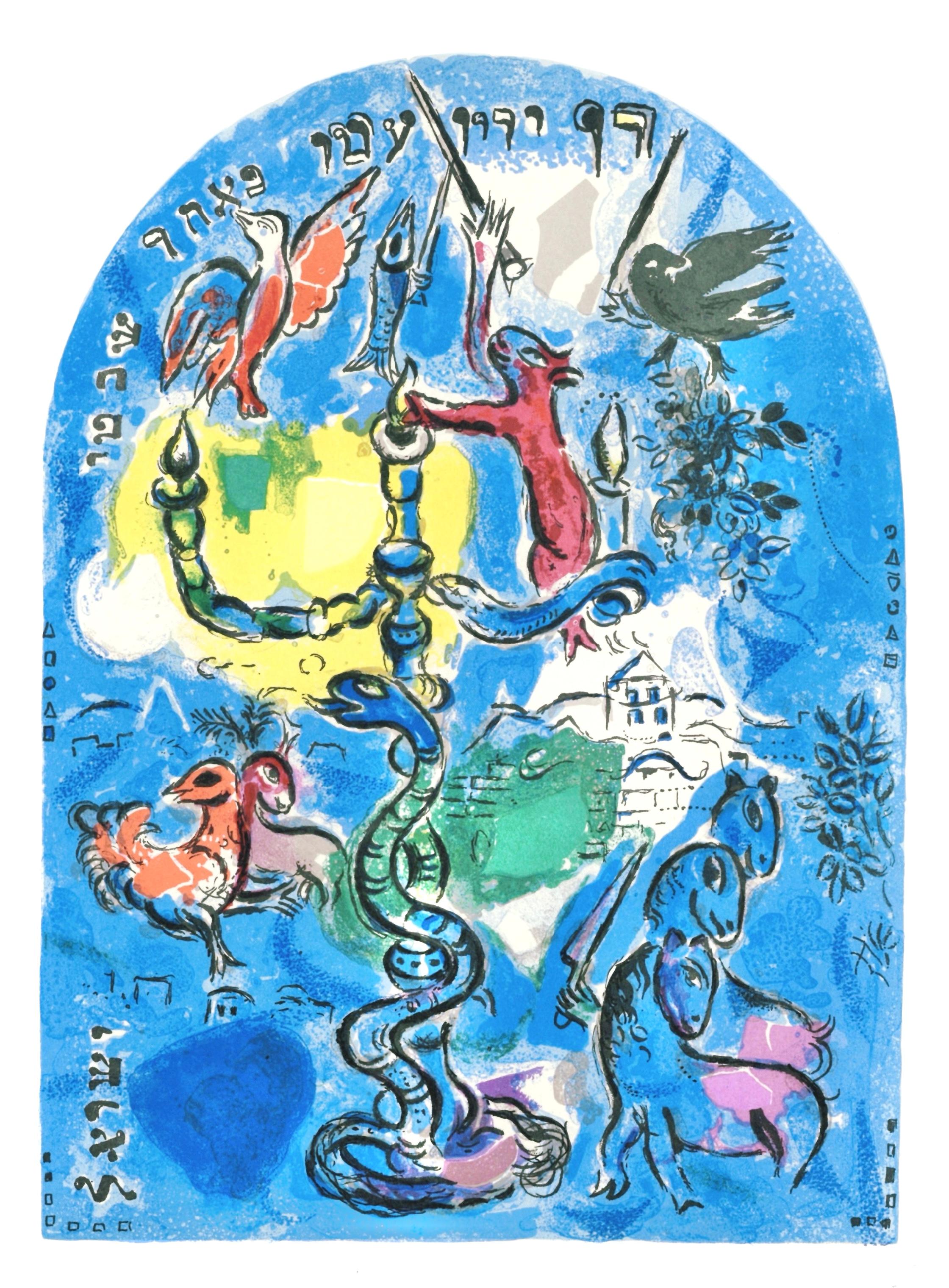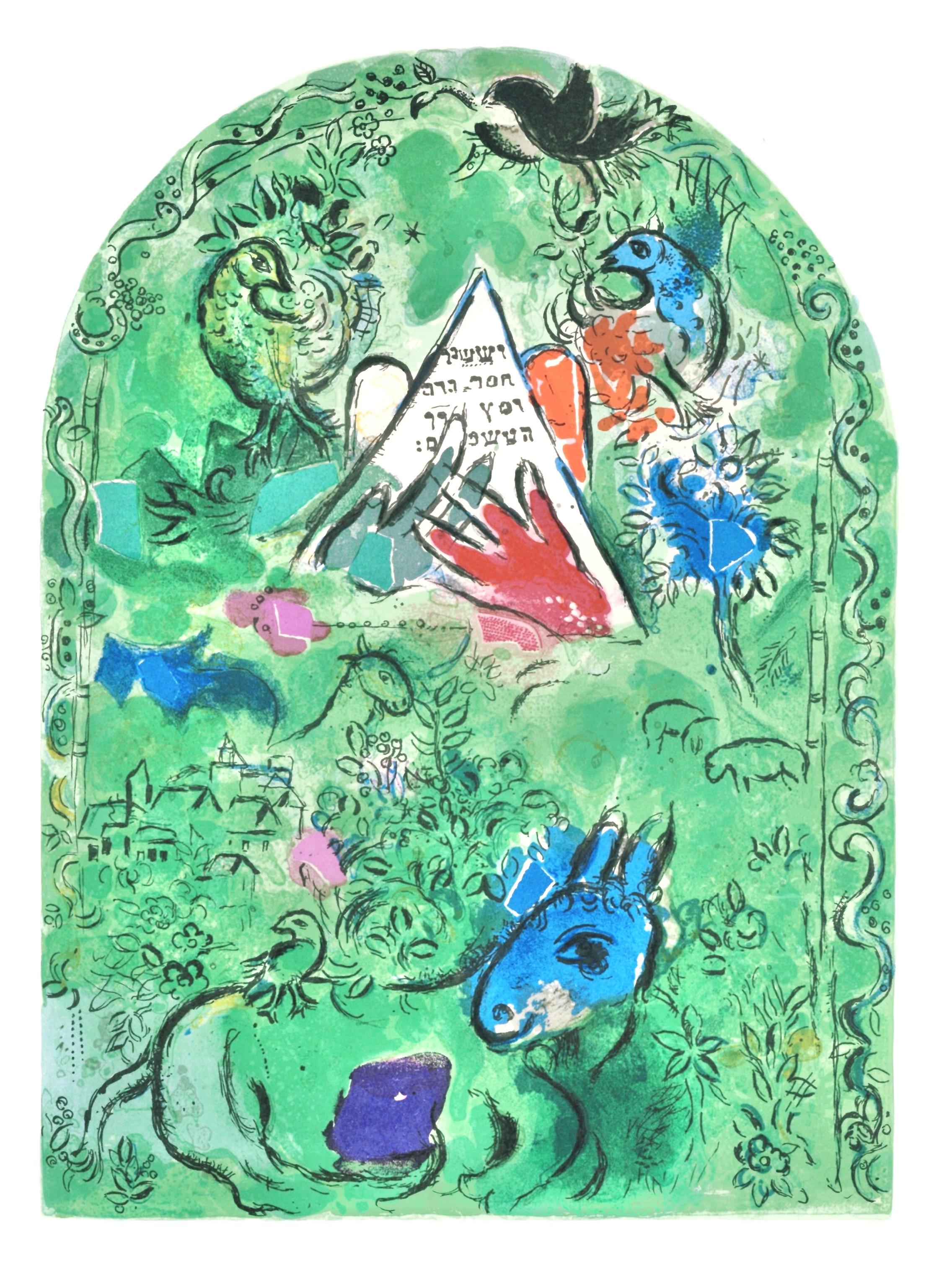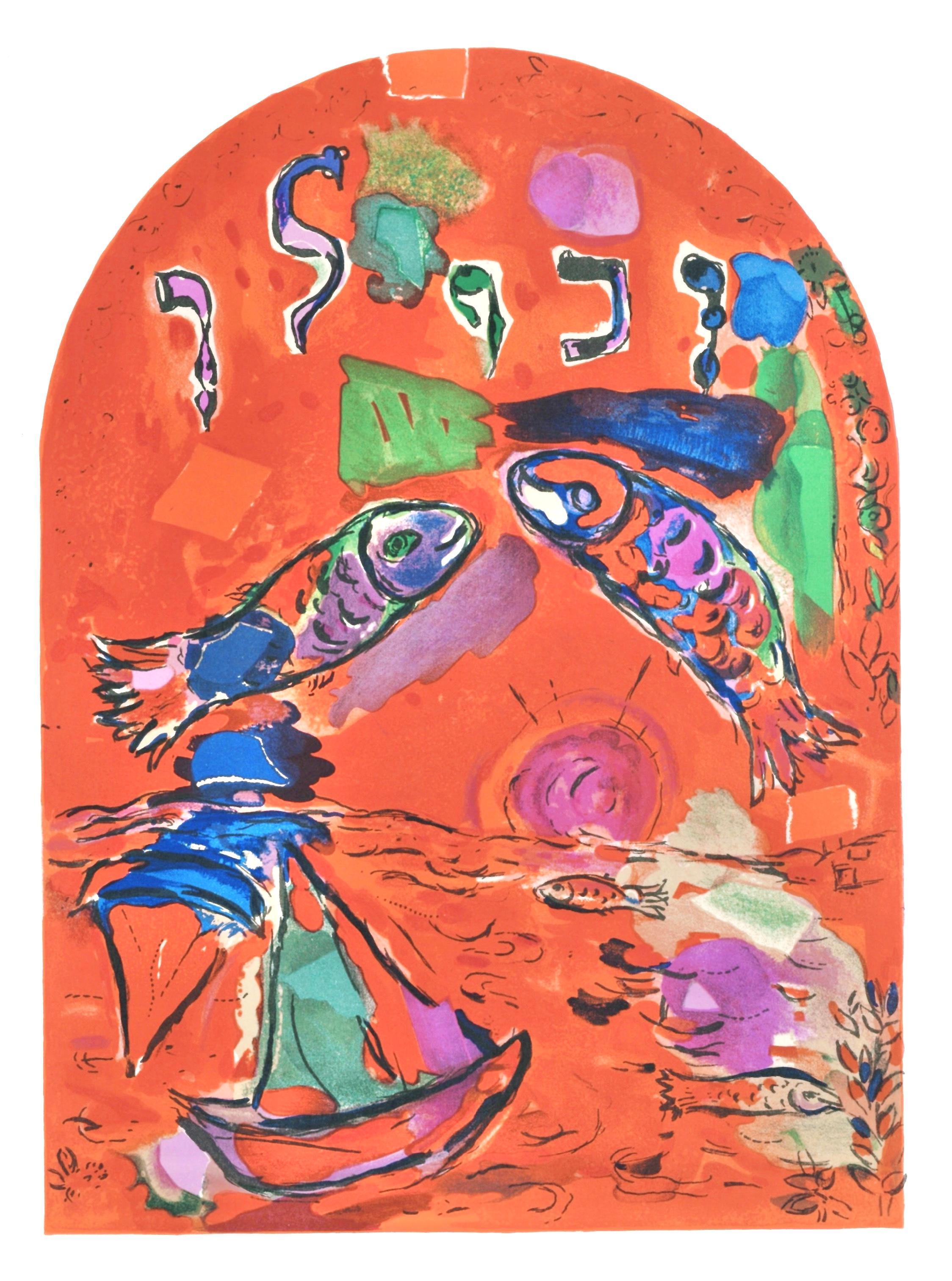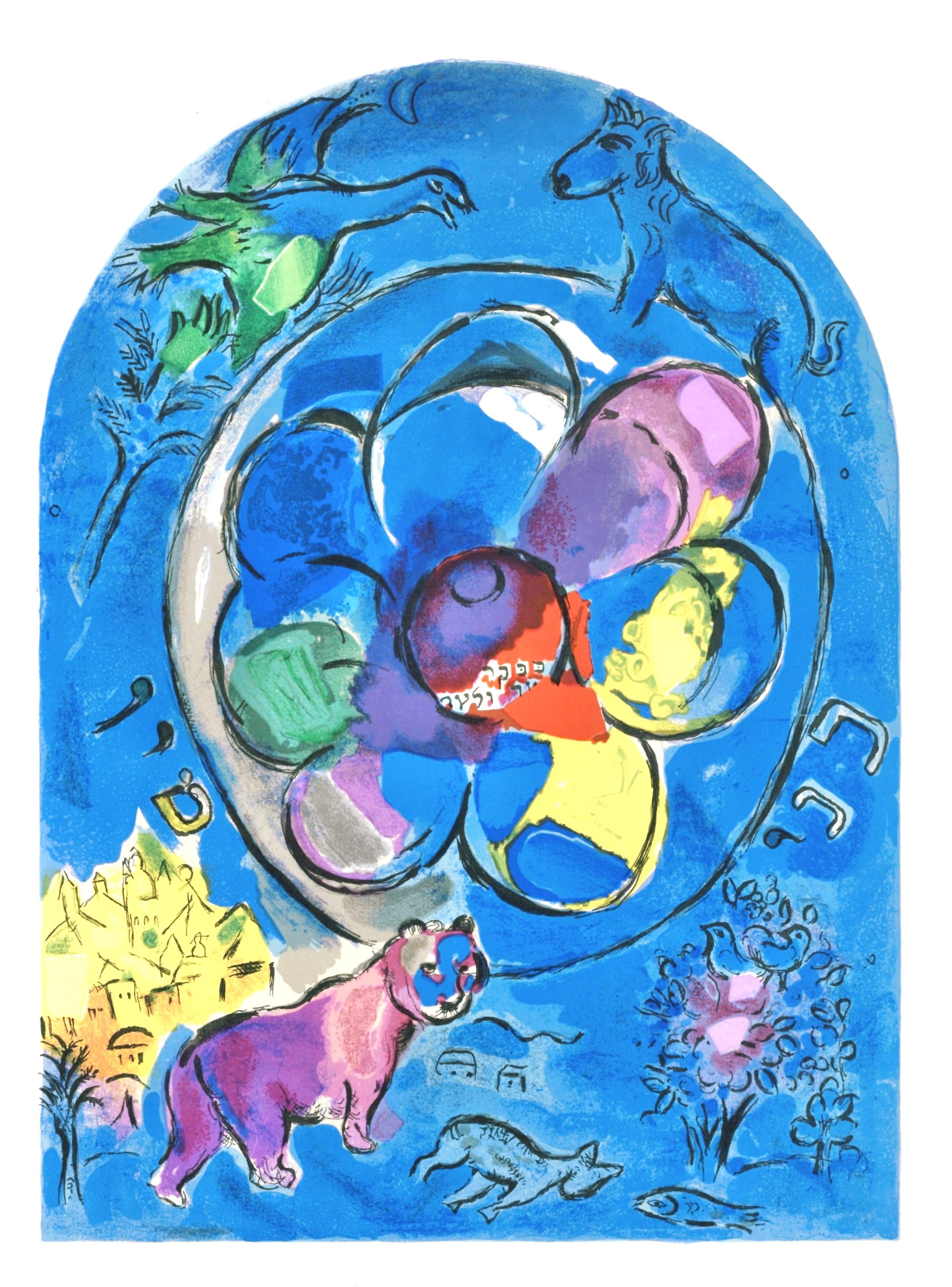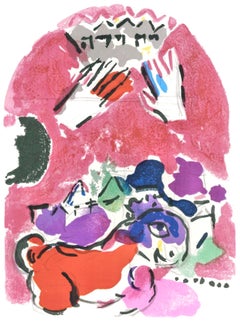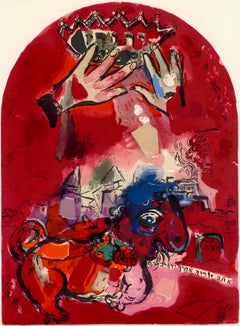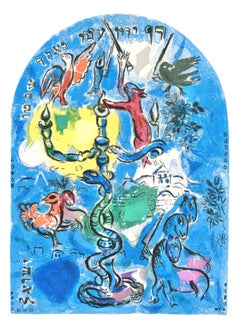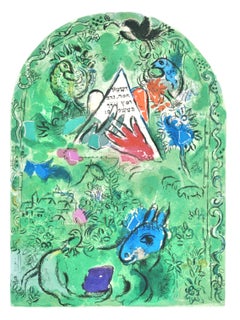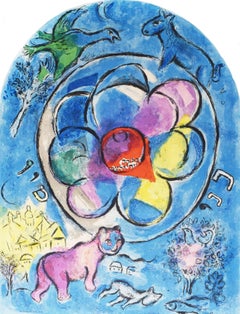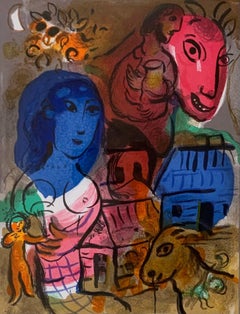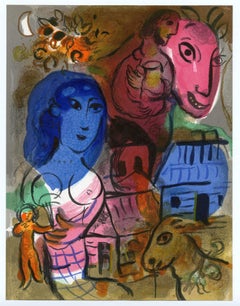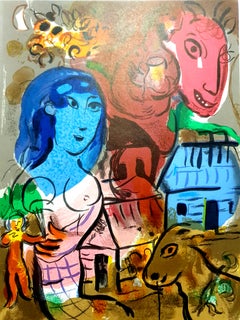Items Similar to Chagall, Tribe of Judah, Marc Chagall, The Jerusalem Windows (after)
Want more images or videos?
Request additional images or videos from the seller
1 of 7
Chagall, Tribe of Judah, Marc Chagall, The Jerusalem Windows (after)1962
1962
$716
$89520% Off
£553.23
£691.5420% Off
€639.59
€799.4920% Off
CA$1,011.76
CA$1,264.7020% Off
A$1,134.76
A$1,418.4420% Off
CHF 594.25
CHF 742.8220% Off
MX$13,788.39
MX$17,235.4920% Off
NOK 7,546.03
NOK 9,432.5420% Off
SEK 7,154.17
SEK 8,942.7120% Off
DKK 4,774.21
DKK 5,967.7620% Off
About the Item
Lithograph on vélin paper. Paper Size: 8 x 6 inches, image; 15 x 11 inches, overall. Inscription: Unsigned and unnumbered, as issued. Notes: From the album, Marc Chagall, The Jerusalem Windows, 1962. Published by André Sauret, Éditeur, Paris; printed by Mourlot Frères, Paris, June 7, 1962. Excerpted from the album, This album, which was compiled by André Sauret, was completed on June 7, 1962. The texts by Jean Leymarie, were composed by hand in "Romain du roi" and were printed by The Imprimerie Nationale de France. The thirty-six preparatory color designs, some of which are in twenty colors, were transferred to the stones by Charles Sorlier under the direction of Marc Chagall. These designs and the two original lithographs by Marc Chagall, were printed by Mourlot Frères. The other reproductions and the binding are by Draeger Frères. The end-papers (photo Izis) show a view of the mountains of Judala taken from the synagogue of the Hadassah-Hebrew University Medical Center. The photographs of the windows and the details in color are by S. Roussel; Those of the sketches and the drawings are by Simone Cuiley-Lagache.
MARC CHAGALL (1897-1985) was a Russian-French artist. An early modernist, he was associated with the École de Paris as well as several major artistic styles and created works in a wide range of artistic formats, including painting, drawings, book illustrations, stained glass, stage sets, ceramics, tapestries and fine art prints. Chagall was born into a Jewish family near Vitebsk, today in Belarus, but at that time in the Pale of Settlement of the Russian Empire. Before World War I, he travelled between Saint Petersburg, Paris, and Berlin. During that period, he created his own mixture and style of modern art, based on his ideas of Eastern European and Jewish folklore. He spent the wartime years in his native Belarus, becoming one of the country's most distinguished artists and a member of the modernist avant-garde, founding the Vitebsk Arts College. He later worked in and near Moscow in difficult conditions during hard times in Russia following the Bolshevik Revolution, before leaving again for Paris in 1923. During World War II, he escaped occupied France to the United States, where he lived in New York City for seven years before returning to France in 1948. Art critic Robert Hughes referred to Chagall as "the quintessential Jewish artist of the twentieth century". According to art historian Michael J. Lewis, Chagall was considered to be "the last survivor of the first generation of European modernists". For decades, he "had also been respected as the world's pre-eminent Jewish artist". Using the medium of stained glass, he produced windows for the cathedrals of Reims and Metz as well as the Fraumünster in Zürich, windows for the UN and the Art Institute of Chicago and the Jerusalem Windows in Israel. He also did large-scale paintings, including part of the ceiling of the Paris Opéra. He experienced modernism's "golden age" in Paris, where "he synthesized the art forms of Cubism, Symbolism, and Fauvism, and the influence of Fauvism gave rise to Surrealism". Yet throughout these phases of his style "he remained most emphatically a Jewish artist, whose work was one long dreamy reverie of life in his native village of Vitebsk." "When Matisse dies", Pablo Picasso remarked in the 1950s, "Chagall will be the only painter left who understands what colour really is.” In November 2017, Chagall’s painting, Les Amoureux, sold for $28.5 million USD at Sotheby's New York, which set the world record for the artist.
- Creation Year:1962
- Dimensions:Height: 12.75 in (32.39 cm)Width: 9.5 in (24.13 cm)
- Medium:
- Movement & Style:
- After:Marc Chagall (1887 - 1985, French)
- Period:
- Condition:
- Gallery Location:Southampton, NY
- Reference Number:1stDibs: LU1465216708212
About the Seller
4.9
Platinum Seller
Premium sellers with a 4.7+ rating and 24-hour response times
Established in 1978
1stDibs seller since 2021
1,157 sales on 1stDibs
Typical response time: <1 hour
- ShippingRetrieving quote...Shipping from: Southampton, NY
- Return Policy
Authenticity Guarantee
In the unlikely event there’s an issue with an item’s authenticity, contact us within 1 year for a full refund. DetailsMoney-Back Guarantee
If your item is not as described, is damaged in transit, or does not arrive, contact us within 7 days for a full refund. Details24-Hour Cancellation
You have a 24-hour grace period in which to reconsider your purchase, with no questions asked.Vetted Professional Sellers
Our world-class sellers must adhere to strict standards for service and quality, maintaining the integrity of our listings.Price-Match Guarantee
If you find that a seller listed the same item for a lower price elsewhere, we’ll match it.Trusted Global Delivery
Our best-in-class carrier network provides specialized shipping options worldwide, including custom delivery.More From This Seller
View AllChagall, Tribe of Judah, Marc Chagall, The Jerusalem Windows (after)
By Marc Chagall
Located in Southampton, NY
Lithograph on vélin paper. Paper Size: 8 x 6 inches, image; 15 x 11 inches, overall. Inscription: Unsigned and unnumbered, as issued. Notes: From the album, Marc Chagall, The Jerusal...
Category
1960s Expressionist Figurative Prints
Materials
Lithograph
$716 Sale Price
20% Off
Chagall, Tribe of Judah, Vitraux pour Jérusalem (after)
By Marc Chagall
Located in Southampton, NY
Lithograph on vélin paper. Inscription: Unsigned and unnumbered, as issued. Good condition, . Notes: From the album, Chagall, Vitraux pour Jérusalem. Published by Musée des Arts Déco...
Category
1960s Expressionist Figurative Prints
Materials
Lithograph
Chagall, Tribe of Dan, Marc Chagall, The Jerusalem Windows (after)
By Marc Chagall
Located in Southampton, NY
Lithograph on vélin paper. Paper Size: 8 x 6 inches, image; 15 x 11 inches, overall. Inscription: Unsigned and unnumbered, as issued. Notes: From the album, Marc Chagall, The Jerusal...
Category
1960s Expressionist Figurative Prints
Materials
Lithograph
$716 Sale Price
20% Off
Chagall, Tribe of Issachar, Marc Chagall, The Jerusalem Windows (after)
By Marc Chagall
Located in Southampton, NY
Lithograph on vélin paper. Paper Size: 8 x 6 inches, image; 15 x 11 inches, overall. Inscription: Unsigned and unnumbered, as issued. Notes: From the album, Marc Chagall, The Jerusal...
Category
1960s Expressionist Figurative Prints
Materials
Lithograph
$716 Sale Price
20% Off
Chagall, Tribe of Zebulun, Marc Chagall, The Jerusalem Windows (after)
By Marc Chagall
Located in Southampton, NY
Lithograph on vélin paper. Paper Size: 8 x 6 inches, image; 15 x 11 inches, overall. Inscription: Unsigned and unnumbered, as issued. Notes: From the album, Marc Chagall, The Jerusal...
Category
1960s Expressionist Figurative Prints
Materials
Lithograph
$716 Sale Price
20% Off
Chagall, Tribe of Benjamin, The Jerusalem Windows (after)
By Marc Chagall
Located in Southampton, NY
Lithograph on vélin paper. Paper Size: 8 x 6 inches, image; 15 x 11 inches, overall. Inscription: Unsigned and unnumbered, as issued. Notes: From the album, Marc Chagall, The Jerusal...
Category
1960s Expressionist Figurative Prints
Materials
Lithograph
$716 Sale Price
20% Off
You May Also Like
The Tribe of Benjamin, from: The Jerusalem Windows - Stained Glass Jewish Tribes
By (after) Marc Chagall
Located in London, GB
This lithograph is hand signed in pencil by the artist "Marc Chagall" in the lower right margin
It is also hand numbered in pencil from the edition of 150, at the lower left margin.
...
Category
1960s Surrealist Figurative Prints
Materials
Lithograph
Homage to Marc Chagall, from XXe Siecle
By Marc Chagall
Located in Washington, DC
Artist: Marc Chagall
Title: Homage to Marc Chagall
Portfolio: XXe Siecle
Medium: Lithograph
Year: 1969
Edition: Unnumbered
Framed Size: 20 1/2" x 17 1/4"
Sheet Size: 12" x 9 1/2"
Im...
Category
1960s Modern Figurative Prints
Materials
Lithograph
XXe Siecle-Hommage a Marc Chagall
By Marc Chagall
Located in Fairlawn, OH
XXe Siecle-Hommage a Marc Chagall
Color lithograph, 1969
Unsigned as issued by XXe Siecle
From: XXe Siecle, Volume, Special Issue Marc Chagall
Published by G. di San Lazzaro for A. M...
Category
1960s French School Figurative Prints
Materials
Lithograph
Marc Chagall - Homage to Marc Chagall - Original Lithograph
By Marc Chagall
Located in Collonge Bellerive, Geneve, CH
Marc Chagall
Original Lithograph
1969
From the revue XXe Siecle, edition of 12,000
Unsigned, as issued
Dimensions: 32 x 24
Condition : Excellent
Reference: Mourlot 572
Marc Chagall (born in 1887)
Marc Chagall was born in Belarus in 1887 and developed an early interest in art. After studying painting, in 1907 he left Russia for Paris, where he lived in an artist colony on the city’s outskirts. Fusing his own personal, dreamlike imagery with hints of the fauvism and cubism popular in France at the time, Chagall created his most lasting work—including I and the Village (1911)—some of which would be featured in the Salon des Indépendants exhibitions. After returning to Vitebsk for a visit in 1914, the outbreak of WWI trapped Chagall in Russia. He returned to France in 1923 but was forced to flee the country and Nazi persecution during WWII. Finding asylum in the U.S., Chagall became involved in set and costume design before returning to France in 1948. In his later years, he experimented with new art forms and was commissioned to produce numerous large-scale works. Chagall died in St.-Paul-de-Vence in 1985.
The Village
Marc Chagall was born in a small Hassidic community on the outskirts of Vitebsk, Belarus, on July 7, 1887. His father was a fishmonger, and his mother ran a small sundries shop in the village. As a child, Chagall attended the Jewish elementary school, where he studied Hebrew and the Bible, before later attending the Russian public school. He began to learn the fundamentals of drawing during this time, but perhaps more importantly, he absorbed the world around him, storing away the imagery and themes that would feature largely in most of his later work.
At age 19 Chagall enrolled at a private, all-Jewish art school and began his formal education in painting, studying briefly with portrait artist Yehuda Pen. However, he left the school after several months, moving to St. Petersburg in 1907 to study at the Imperial Society for the Protection of Fine Arts. The following year, he enrolled at the Svanseva School, studying with set designer Léon Bakst, whose work had been featured in Sergei Diaghilev's Ballets Russes. This early experience would prove important to Chagall’s later career as well.
Despite this formal instruction, and the widespread popularity of realism in Russia at the time, Chagall was already establishing his own personal style, which featured a more dreamlike unreality and the people, places and imagery that were close to his heart. Some examples from this period are his Window Vitebsk (1908) and My Fianceé with Black Gloves (1909), which pictured Bella Rosenfeld, to whom he had recently become engaged.
The Beehive
Despite his romance with Bella, in 1911 an allowance from Russian parliament member and art patron Maxim Binaver enabled Chagall to move to Paris, France. After settling briefly in the Montparnasse neighborhood, Chagall moved further afield to an artist colony known as La Ruche (“The Beehive”), where he began to work side by side with abstract painters such as Amedeo Modigliani and Fernand Léger as well as the avant-garde poet Guillaume Apollinaire. At their urging, and under the influence of the wildly popular fauvism and cubism, Chagall lightened his palette and pushed his style ever further from reality. I and the Village (1911) and Homage to Apollinaire (1912) are among his early Parisian works, widely considered to be his most successful and representative period.
Though his work stood stylistically apart from his cubist contemporaries, from 1912 to 1914 Chagall exhibited several paintings at the annual Salon des Indépendants exhibition, where works by the likes of Juan Gris, Marcel Duchamp and Robert Delaunay were causing a stir in the Paris art world. Chagall’s popularity began to spread beyond La Ruche, and in May 1914 he traveled to Berlin to help organize his first solo exhibition, at Der Sturm Gallery. Chagall remained in the city until the highly acclaimed show opened that June. He then returned to Vitebsk, unaware of the fateful events to come.
War, Peace and Revolution
In August 1914 the outbreak of World War I precluded Chagall’s plans to return to Paris. The conflict did little to stem the flow of his creative output, however, instead merely giving him direct access to the childhood scenes so essential to his work, as seen in paintings such as Jew in Green (1914) and Over Vitebsk (1914). His paintings from this period also occasionally featured images of the war’s impact on the region, as with Wounded Soldier (1914) and Marching (1915). But despite the hardships of life during wartime, this would also prove to be a joyful period for Chagall. In July 1915 he married Bella, and she gave birth to a daughter, Ida, the following year. Their appearance in works such as Birthday (1915), Bella and Ida by the Window (1917) and several of his “Lovers” paintings give a glimpse of the island of domestic bliss that was Chagall’s amidst the chaos.
To avoid military service and stay with his new family, Chagall took a position as a clerk in the Ministry of War Economy in St. Petersburg. While there he began work on his autobiography and also immersed himself in the local art scene, befriending novelist Boris Pasternak, among others. He also exhibited his work in the city and soon gained considerable recognition. That notoriety would prove important in the aftermath of the 1917 Russian Revolution when he was appointed as the Commissar of Fine Arts in Vitebsk. In his new post, Chagall undertook various projects in the region, including the 1919 founding of the Academy of the Arts. Despite these endeavors, differences among his colleagues eventually disillusioned Chagall. In 1920 he relinquished his position and moved his family to Moscow, the post-revolution capital of Russia.
In Moscow, Chagall was soon commissioned to create sets and costumes for various productions at the Moscow State Yiddish Theater, where he would paint a series of murals titled Introduction to the Jewish Theater as well. In 1921, Chagall also found work as a teacher at a school for war orphans. By 1922, however, Chagall found that his art had fallen out of favor, and seeking new horizons he left Russia for good.
Flight
After a brief stay in Berlin, where he unsuccessfully sought to recover the work exhibited at Der Sturm before the war, Chagall moved his family to Paris in September 1923. Shortly after their arrival, he was commissioned by art dealer and publisher Ambroise Vollard to produce a series of etchings for a new edition of Nikolai Gogol's 1842 novel Dead Souls. Two years later Chagall began work on an illustrated edition of Jean de la Fontaine’s Fables, and in 1930 he created etchings for an illustrated edition of the Old Testament, for which he traveled to Palestine to conduct research.
Chagall’s work during this period brought him new success as an artist and enabled him to travel throughout Europe in the 1930s. He also published his autobiography, My Life (1931), and in 1933 received a retrospective at the Kunsthalle in Basel, Switzerland. But at the same time that Chagall’s popularity was spreading, so, too, was the threat of Fascism and Nazism. Singled out during the cultural "cleansing" undertaken by the Nazis in Germany, Chagall’s work was ordered removed from museums throughout the country. Several pieces were subsequently burned, and others were featured in a 1937 exhibition of “degenerate art” held in Munich. Chagall’s angst regarding these troubling events and the persecution of Jews in general can be seen in his 1938 painting White Crucifixion.
With the eruption of World War II, Chagall and his family moved to the Loire region before moving farther south to Marseilles following the invasion of France. They found a more certain refuge when, in 1941, Chagall’s name was added by the director of the Museum of Modern Art (MOMA) in New York City to a list of artists and intellectuals deemed most at risk from the Nazis’ anti-Jewish campaign. Chagall and his family would be among the more than 2,000 who received visas and escaped this way.
Haunted Harbors
Arriving in New York City in June 1941, Chagall discovered that he was already a well-known artist there and, despite a language barrier, soon became a part of the exiled European artist community. The following year he was commissioned by choreographer Léonide Massine to design sets and costumes for the ballet Aleko, based on Alexander Pushkin’s “The Gypsies” and set to the music of Pyotr Ilyich Tchaikovsky.
But even as he settled into the safety of his temporary home, Chagall’s thoughts were frequently consumed by the fate befalling the Jews of Europe and the destruction of Russia, as paintings such as The Yellow Crucifixion...
Category
1960s Surrealist Figurative Prints
Materials
Lithograph
"Tribe of Judah" lithograph
By (after) Marc Chagall
Located in Henderson, NV
Medium: lithograph (after the gouache). Printed in 1962 at the Mourlot atelier for "Jerusalem Windows". This piece was executed by Chagall in preparation for his famous stained-glass...
Category
1960s Prints and Multiples
Materials
Lithograph
The Face of Israel
By Marc Chagall
Located in OPOLE, PL
Marc Chagall (1887-1985) - The Face of Israel
Lithograph from 1960.
Dimensions of work: 35 x 26 cm
Publisher: Tériade, Paris.
The work is in Excellent condition.
Fast and secure...
Category
20th Century Modern Figurative Prints
Materials
Lithograph
More Ways To Browse
Brexit Nightmare
Dali Heterosexual
Frank Cassara
Kalman Kubinyi
Katarina Vavrova
Lord Leighton Photogravure
Louis Vuitton Silver Trainers
Tom Wesselmann Lulu
Norman Hirst
Roy Lichtenstein Pistol
Roy Lichtenstein Sweet Dreams
Takeda Shingen
Max Walter Svanberg
Leroy Neiman Stud Poker
Marcus Glenn Art
Peter Bonde
Raphael Et La Fornarina
Dali Man Of La Mancha
